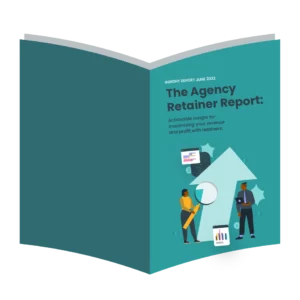Recent years have seen agencies weather a perfect storm of rising costs, falling client budgets, and limited revenue streams. The pandemic brought with it a host of new challenges - and agencies had to quickly adapt in order to survive. For those who did, the financial challenges are not over quite yet. The good news is: as a way to guarantee rolling, dependable income, retainer packages have the potential to alleviate some of the pressure conferred by these circumstances - if they’re properly utilised, that is.
That’s why we’ve published The agency retainer report: Actionable insight for maximising your revenue and profit with retainers, to help you make the most of your recurring offering.
We surveyed almost 200 agencies to learn more about how they currently approach retainers, and used our findings to establish a new retainers best practice. Plus, we spoke with three industry experts to gather their thoughts on the research outcomes and their advice for how agencies can best put the report findings into practice.
The agency retainer report will help you decide the ideal agency retainer fee, the best set-up for your web development retainer, and offers benchmarks across the whole digital marketing retainer industry. And that’s only the start.

Make the most of your agency’s retainers.
Use our insight report to help you reimagine your retainers and raise your profits.How retainers are used now
Our survey was open during June and July 2022. During that time 198 agencies contributed to the survey, the largest cohort of which (31.31%) defined themselves as full service. Most agencies reported spending between 8-14 days on an average retainer each month, with the most common profit percentage from retainers being between 21-30% (24.24%). Notably, though, there was a far greater distribution between profit margins as between time spent, implying that it is factors such as the content and pricing of the retainer packages offered by agencies, and not simply their time-allocation or complexity, which has the greatest influence on overall retainer-based turnover. We sat down with industry experts to hear more about their impression of agencies’ current view of retainers – especially post-pandemic.

“There’s a greater awareness among agencies that regular recurring revenue from clients is a good thing,” said Janusz Stabik, Managing Partner at GYDA. “More people are advocating for having a higher proportion of revenue from a retainer structure”. Joe Hine, Partner at SI Partners, agreed. “Agencies are looking for ways to ‘de-risk’ their investments,” he explained. “With retainers, you have a very high visibility over spend”.
And Paul Barnes, Accountant and founder of MAP, suggested that retainers are viewed as a way to, “build an easier, simpler, more lucrative business that doesn’t require you to go out hustling and winning new work all the time”. Still, all three of these experts identified elements of uncertainty within agencies when it came to their retainers.
More people are advocating for having a higher proportion of revenue from a retainer structure
Joe Hine, Partner at SI Partners
“Agencies are really fearful of putting prices up,” said Janusz, while Paul suggested that agencies are “not focusing on the customer, and on what constitutes value for the customer” – which is directly impacting their ability to price-up their offerings.
That really matters, because pressure from clients can affect not only the price of retainers, but also how often they are renewed, how they are delivered, and consequently how much time agencies have to devote to chasing new business opportunities. For Joe, proving ROI to clients is a real issue for many agencies: “Agencies absolutely struggle with proving it,” he said. “But it needs to be part of the narrative.”
With these challenges in mind, we ran our survey to discover not only what challenges agencies are facing, but also how they are working to overcome these challenges, and where some are missing opportunities to scale. You can read more insights from Joe, Janusz and Paul in the full report.
Our research found that the most common way to charge for retainers:
- Weekly (30.30%)
- Daily (22.73%)
- Monthly (20.20%)
The least popular way to charge was quarterly, with only 4.55% uptake.
The future of retainers
The findings of our survey show that while the average agency earns between 21-30% of their profit from retainers, several factors could greatly influence this profit margin. For example, agencies who offered SEO services within their packages saw that profit jump to between 31-40%. Similarly, agencies who offered web hosting services within their retainers had a turnover 100% higher than the average respondent. Evidence therefore suggests that most agencies stand to benefit from restructuring their packages in order to guarantee the most consistent growth.
Our report, which expands on these survey findings, includes a checklist, which outlines actionable steps agencies can take to better align with these best practices – You can read the full ‘best practices’ checklist within the report. Additional possibilities we identified within the survey responses were: adding complementary services, including a mark-up on web hosting, and including overhead costs within retainer pricing. Making these changes is recommended in order for agencies to benefit from a higher percentage of visible recurring revenue – something which would mean a more efficient and profitable business, with less monthly pressure.
A recurring and retainer-based model is definitely a method through which profitability can be increased
Janusz Stabik, Managing Partner at GYDA
While, for Paul, a higher focus on retainers is beneficial for both agencies and their clients: “Retainers drive the most value, especially in today’s marketplace.”
Streamlined retainers, streamlined profits
For many agencies, retainers provide a reliable backbone to their business structure. They provide certainty over income, visibility when budgeting, and ensure a rolling revenue even during uncertain times. However, our research identified potential opportunities available to most agencies who revisit their approach to their retainer packages. Rather than accepting them as an unexciting but dependable element of your business structure, viewing retainers as sites of growth has the potential to supercharge your profit margin.
The good news? Our research found that achieving consistent growth is a matter of several small changes, (rather than total retainer overhauls), and an attitude shift among agencies.

